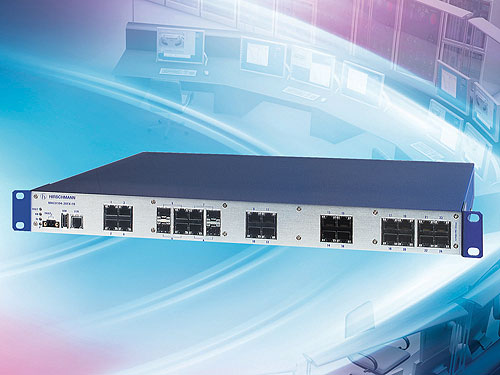

On the other hand, if you configure the Switch with a Default Gateway, the Switch needs to issue only one ARP Broadcast to learn the MAC Address of its configured default gateway.Client-level security that allows LAN access to 802.1X clients (up to 32 per port) with valid user credentials Notice that without a configured default gateway the Switch needs to issue an ARP Broadcast for every new non-local IP Address it wants to communicate with, meaning that the Switch's ARP Table will list an entry for every non-local IP Address pointing to the same MAC Address (the local router's interface MAC Address). Here's a diagram explaining the whole process:
#Hirschmann switch interface how to
Well, turns out that although the Switch's VLAN 1 Interface doesn't know the IP Address of its Default Gateway, it issues an ARP Broadcast to learn the MAC Address of packet's destination Host (just like it would if the packet's destination IP Address was in the same subnet) and once the router's LAN Interface receives the ARP Broadcast message it tries to match the Target IP Address to any of its routes, if a match is found (meaning that the router knows how to get to the subnet the Target IP Address resides in), then it replies with the MAC Address of the interface in which the ARP Message was received. So, the question is how come the Switch's VLAN 1 Interface is a able to send data to the local router/gateway if it hasn't been configured with such? Hosts send packets to its default gateway when the packet's destination IP Address is in a different subnet, and if no default gateway has been configured they simply can't communication outside its local subnet. I could ping/telnet to it not only from a host on the same subnet, but also from hosts on remote subnets. I was also puzzled to know that even though I did not configure a default gateway (using the ip default-gateway command) on my Catalyst 2960 L2 Switch. When I want to Telnet to the switch, I set the IP address of the VLAN Multicast doesn't cross layer-3 boundaries, either, unless a router is configured to route multicast (off by default). This doesn't interrupt every host on the LAN, and it, in all probability, with only hit the host for which it wants to resolve the layer-2 address. IPv6 does basically the same thing, but IPv6 doesn't have broadcasts, so it uses a special multicast group based on the last 24 bits of the IPv6 address. If the destination is on a different layer-3 network, the host (including the switch management) will send the frame to the gateway's layer-2 address. The host (including the switch management) can tell if the destination layer-3 address is outside its network because it has its own layer-3 address, the destination layer-3 address, and the network mask of its network. Broadcasts do not cross layer-3 boundaries (routers). The host (including the switch management) sends an ARP (Address Resolution Protocol) request via a broadcast to do the resolution. When a host (including the switch management), wants to send a packet to another host, it needs to resolve the layer-3 address (IP, etc.) to the other host's layer-2 address (MAC, etc.) in order to build a layer-2 frame. Without a default gateway, the switch management address (on VLAN 1 in your case, but it could be on any VLAN configured on the switch) cannot send traffic off its network to another network. The default gateway on a switch has the same function as any gateway configured on a host PC. Telnet is a bidirectional protocol, and the switch, without the default gateway, would be unable to respond to the host which is attempting to establish the Telnet session.

The switch management cannot send anything to a different layer-3 network without a default gateway.


 0 kommentar(er)
0 kommentar(er)
